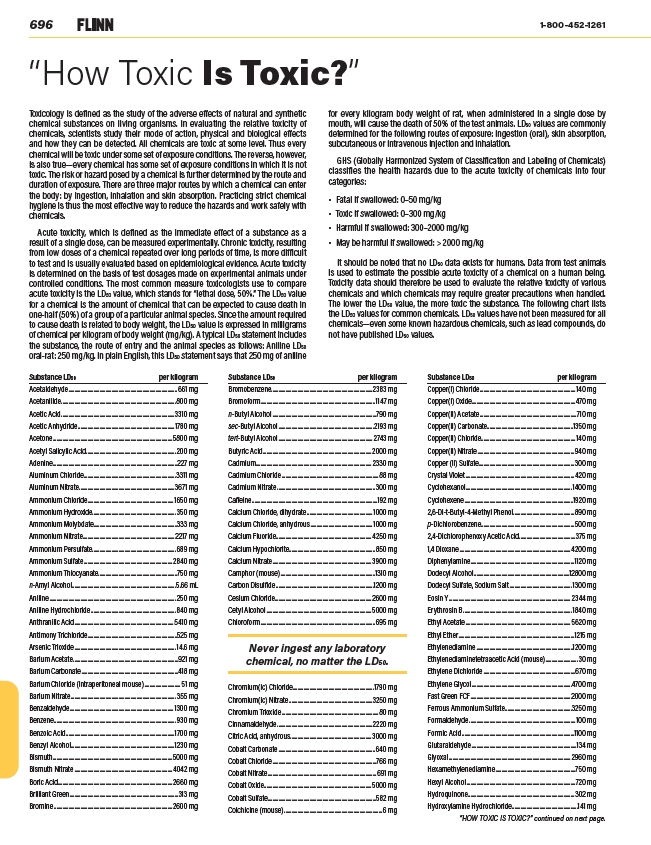
696 1-800-452-1261
“How Toxic Is Toxic?”
Toxicology is defined as the study of the adverse effects of natural and synthetic
chemical substances on living organisms. In evaluating the relative toxicity of
chemicals, scientists study their mode of action, physical and biological effects
and how they can be detected. All chemicals are toxic at some level. Thus every
chemical will be toxic under some set of exposure conditions. The reverse, however,
is also true—every chemical has some set of exposure conditions in which it is not
toxic. The risk or hazard posed by a chemical is further determined by the route and
duration of exposure. There are three major routes by which a chemical can enter
the body: by ingestion, inhalation and skin absorption. Practicing strict chemical
hygiene is thus the most effective way to reduce the hazards and work safely with
chemicals.
Acute toxicity, which is defined as the immediate effect of a substance as a
result of a single dose, can be measured experimentally. Chronic toxicity, resulting
from low doses of a chemical repeated over long periods of time, is more difficult
to test and is usually evaluated based on epidemiological evidence. Acute toxicity
is determined on the basis of test dosages made on experimental animals under
controlled conditions. The most common measure toxicologists use to compare
acute toxicity is the LD50 value, which stands for “lethal dose, 50%.” The LD50 value
for a chemical is the amount of chemical that can be expected to cause death in
one-half (50%) of a group of a particular animal species. Since the amount required
to cause death is related to body weight, the LD50 value is expressed in milligrams
of chemical per kilogram of body weight (mg/kg). A typical LD50 statement includes
the substance, the route of entry and the animal species as follows: Aniline LD50
oral-rat: 250 mg/kg. In plain English, this LD50 statement says that 250 mg of aniline
for every kilogram body weight of rat, when administered in a single dose by
mouth, will cause the death of 50% of the test animals. LD50 values are commonly
determined for the following routes of exposure: ingestion (oral), skin absorption,
subcutaneous or intravenous injection and inhalation.
GHS (Globally Harmonized System of Classification and Labeling of Chemicals)
classifies the health hazards due to the acute toxicity of chemicals into four
categories:
• Fatal if swallowed: 0–50 mg/kg
• Toxic if swallowed: 0–300 mg/kg
• Harmful if swallowed: 300–2000 mg/kg
• May be harmful if swallowed: > 2000 mg/kg
It should be noted that no LD50 data exists for humans. Data from test animals
is used to estimate the possible acute toxicity of a chemical on a human being.
Toxicity data should therefore be used to evaluate the relative toxicity of various
chemicals and which chemicals may require greater precautions when handled.
The lower the LD50 value, the more toxic the substance. The following chart lists
the LD50 values for common chemicals. LD50 values have not been measured for all
chemicals—even some known hazardous chemicals, such as lead compounds, do
not have published LD50 values.
Substance LD50 per kilogram
Acetaldehyde............................................................................................661 mg
Acetanilide.................................................................................................800 mg
Acetic Acid................................................................................................3310 mg
Acetic Anhydride..................................................................................1780 mg
Acetone.....................................................................................................5800 mg
Acetyl Salicylic Acid............................................................................200 mg
Adenine.........................................................................................................227 mg
Aluminum Chloride..............................................................................3311 mg
Aluminum Nitrate.................................................................................3671 mg
Ammonium Chloride.........................................................................1650 mg
Ammonium Hydroxide.......................................................................350 mg
Ammonium Molybdate......................................................................333 mg
Ammonium Nitrate.............................................................................2217 mg
Ammonium Persulfate.......................................................................689 mg
Ammonium Sulfate...........................................................................2840 mg
Ammonium Thiocyanate..................................................................750 mg
n-Amyl Alcohol........................................................................................5.66 mL
Aniline...........................................................................................................250 mg
Aniline Hydrochloride........................................................................840 mg
Anthranilic Acid....................................................................................5410 mg
Antimony Trichloride............................................................................525 mg
Arsenic Trioxide...................................................................................... 14.6 mg
Barium Acetate.........................................................................................921 mg
Barium Carbonate..................................................................................418 mg
Barium Chloride (intraperitoneal mouse)............................... 51 mg
Barium Nitrate......................................................................................... 355 mg
Benzaldehyde........................................................................................ 1300 mg
Benzene.......................................................................................................930 mg
Benzoic Acid............................................................................................1700 mg
Benzyl Alcohol........................................................................................1230 mg
Bismuth.....................................................................................................5000 mg
Bismuth Nitrate...................................................................................4042 mg
Boric Acid................................................................................................2660 mg
Brilliant Green............................................................................................313 mg
Bromine....................................................................................................2600 mg
“HOW TOXIC IS TOXIC?” continued on next page.
Substance LD50 per kilogram
Bromobenzene.....................................................................................2383 mg
Bromoform.................................................................................................1147 mg
n-Butyl Alcohol........................................................................................790 mg
sec-Butyl Alcohol.................................................................................2193 mg
tert-Butyl Alcohol................................................................................2743 mg
Butyric Acid............................................................................................2000 mg
Cadmium................................................................................................. 2330 mg
Cadmium Chloride..................................................................................88 mg
Cadmium Nitrate...................................................................................300 mg
Caffeine..........................................................................................................192 mg
Calcium Chloride, dihydrate........................................................1000 mg
Calcium Chloride, anhydrous.....................................................1000 mg
Calcium Fluoride................................................................................4250 mg
Calcium Hypochlorite.........................................................................850 mg
Calcium Nitrate....................................................................................3900 mg
Camphor (mouse)................................................................................1310 mg
Carbon Disulfide...................................................................................1200 mg
Cesium Chloride..................................................................................2600 mg
Cetyl Alcohol.........................................................................................5000 mg
Chloroform.................................................................................................695 mg
Never ingest any laboratory
chemical, no matter the LD50.
Chromium(ic) Chloride....................................................................1790 mg
Chromium(ic) Nitrate.......................................................................3250 mg
Chromium Trioxide..................................................................................80 mg
Cinnamaldehyde.................................................................................2220 mg
Citric Acid, anhydrous.....................................................................3000 mg
Cobalt Carbonate..................................................................................640 mg
Cobalt Chloride........................................................................................766 mg
Cobalt Nitrate............................................................................................ 691 mg
Cobalt Oxide...........................................................................................5000 mg
Cobalt Sulfate............................................................................................582 mg
Colchicine (mouse)...................................................................................6 mg
Substance LD50 per kilogram
Copper(I) Chloride.................................................................................140 mg
Copper(I) Oxide.......................................................................................470 mg
Copper(II) Acetate..................................................................................710 mg
Copper(II) Carbonate.........................................................................1350 mg
Copper(II) Chloride...............................................................................140 mg
Copper(II) Nitrate..................................................................................940 mg
Copper (II) Sulfate.................................................................................300 mg
Crystal Violet............................................................................................420 mg
Cyclohexanol..........................................................................................1400 mg
Cyclohexene............................................................................................1920 mg
2,6-Di-t-Butyl-4-Methyl Phenol....................................................890 mg
p-Dichlorobenzene..............................................................................500 mg
2,4-Dichlorophenoxy Acetic Acid................................................375 mg
1,4 Dioxane..............................................................................................4200 mg
Diphenylamine........................................................................................1120 mg
Dodecyl Alcohol.................................................................................12800 mg
Dodecyl Sulfate, Sodium Salt..................................................... 1300 mg
Eosin Y....................................................................................................... 2344 mg
Erythrosin B............................................................................................ 1840 mg
Ethyl Acetate.........................................................................................5620 mg
Ethyl Ether..................................................................................................1215 mg
Ethylenediamine..................................................................................1200 mg
Ethylenediaminetetraacetic Acid (mouse)............................30 mg
Ethylene Dichloride..............................................................................670 mg
Ethylene Glycol.....................................................................................4700 mg
Fast Green FCF.....................................................................................2000 mg
Ferrous Ammonium Sulfate.........................................................3250 mg
Formaldehyde..........................................................................................100 mg
Formic Acid...............................................................................................1100 mg
Glutaraldehyde.........................................................................................134 mg
Glyoxal.......................................................................................................2960 mg
Hexamethylenediamine....................................................................750 mg
Hexyl Alcohol............................................................................................720 mg
Hydroquinone.......................................................................................... 302 mg
Hydroxylamine Hydrochloride........................................................141 mg